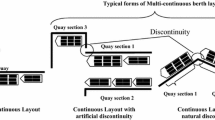Abstract
One of the foremost planning problems in container transshipment operation concerns the allocation of home berth (preferred berthing location) to a set of vessels scheduled to call at the terminal on a weekly basis. The home berth location is subsequently used as a key input to yard storage, personnel, and equipment deployment planning. For instance, the yard planners use the home berth template to plan for the storage locations of transshipment containers within the terminal. These decisions (yard storage plan) are in turn used as inputs in actual berthing operations, when the vessels call at the terminal. In this paper, we study the economical impact of the home berth template design problem on container terminal operations. In particular, we show that it involves a delicate trade-off between the service (waiting time for vessels) and cost (movement of containers between berth and yard) dimension of operations in the terminal. The problem is further exacerbated by the fact that the actual arrival time of the vessels often deviates from the scheduled arrival time, resulting in last-minute scrambling and change of plans in the terminal operations. Practitioners on the ground deal with this issue by building (capacity) buffers in the operational plan and to scramble for additional resources if needs be. We propose a framework to address the home berth design problem. We model this as a rectangle packing problem on a cylinder and use a sequence pair based simulated annealing algorithm to solve the problem. The sequence pair approach allows us to optimize over a large class of packing efficiently and decomposes the home berth problem with data uncertainty into two smaller subproblems that can be readily handled using techniques from stochastic project scheduling. To evaluate the quality of a template, we use a dynamic berth allocation package developed recently by Dai et al. (unpublished manuscript, 2004) to obtain various berthing statistics associated with the template. Extensive computational results show that the proposed model is able to construct efficient and robust template for transshipment hub operations.

















Similar content being viewed by others
References
Brown GG, Lawphongpanich S, Thurman KP (1994) Optimizing ship berthing. Nav Res Logist 41:1–15
Chen CY, Hsieh TW (1999) A time–space network model for the berth allocation problem. In: 19th IFIP TC7 conference on system modeling and optimization, Cambridge, England, 12–16 July 1999
Imahori S, Yagiura M, Ibaraki T (2003) Local search algorithms for the rectangle packing problem with general spatial costs. Math Program Ser B 97:543–569
Lim A (1998) On the ship berthing problem. Oper Res Lett 22(2–3):105–110
Murata H, Fujiyoshi K, Nakatake S, Kajitani Y (1996) VLSI module placement based on rectangle packing by the sequence pair. IEEE Trans Comput-Aided Des Integr Circuits Syst 15(12):1518–1524
Murata H, Fujiyoshi K, Kaneko M (1998). VLSI/PCB placement with obstacles based on sequence pair. IEEE Trans Comput-Aided Des Integr Circuits Syst 17:60–68
Murty KG, Liu JY, Wan YW, Linn R (2005) A decision support system for operations in a container terminal. Decis Support Syst 39(3):309–332
Tang X, Tian R, Wong DF (2000) Fast evaluation of sequence pair in block placement by longest common subsequence computation. In: Proceedings of the conference on design,, automation and test in Europe, pp 106–111
Author information
Authors and Affiliations
Corresponding author
Additional information
Part of this work was done when the second author was at the SKK Graduate School of Business, Sungkyunkwan University, South Korea.
Rights and permissions
About this article
Cite this article
Moorthy, R., Teo, CP. Berth management in container terminal: the template design problem. OR Spectrum 28, 495–518 (2006). https://doi.org/10.1007/s00291-006-0036-5
Published:
Issue Date:
DOI: https://doi.org/10.1007/s00291-006-0036-5




